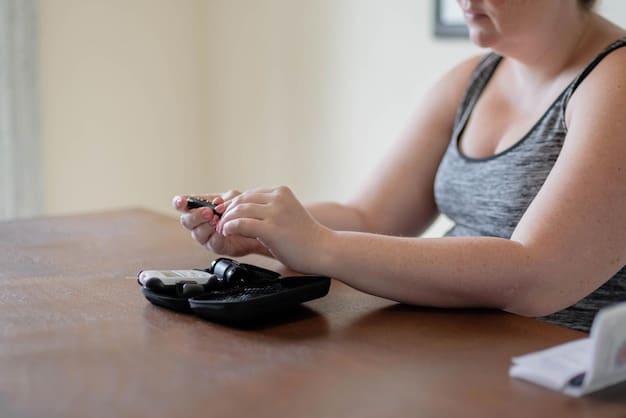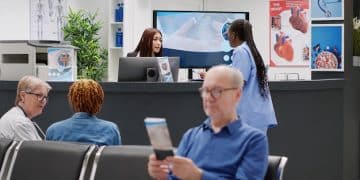Telehealth for Diabetes: Better Outcomes, Fewer Hospitalizations

Telehealth and diabetes management are revolutionizing healthcare by improving patient outcomes and reducing hospitalizations through remote monitoring, virtual consultations, and personalized care plans.
Telehealth and diabetes management: improving outcomes and reducing hospitalizations is becoming increasingly vital in modern healthcare as it offers accessible, convenient, and efficient solutions for managing this chronic condition. Telehealth bridges gaps in care, empowering patients to take control of their health from the comfort of their homes.
The Rise of Telehealth in Chronic Disease Management
Telehealth, the use of technology to deliver healthcare remotely, has transformed how chronic diseases are managed. It overcomes geographical barriers and provides continuous support, making healthcare more accessible and patient-centered.
For patients with diabetes, telehealth tools offer numerous benefits, from remote monitoring of blood glucose levels to virtual consultations with endocrinologists and diabetes educators.
Benefits of Telehealth
Telehealth provides several advantages in managing chronic conditions like diabetes. It enhances patient engagement, improves adherence to treatment plans, and allows for timely interventions.
- Accessibility: Telehealth removes geographical barriers, making healthcare accessible to patients in rural or underserved areas.
- Convenience: Virtual appointments and remote monitoring eliminate the need for frequent visits, saving time and reducing travel costs.
- Personalized Care: Telehealth enables tailored interventions based on real-time data, ensuring each patient receives individualized attention.
Moreover, telehealth reduces the burden on healthcare facilities, decreasing hospital readmissions and emergency room visits.
Remote Monitoring: A Key Component of Telehealth
Remote monitoring involves using devices and digital platforms to track vital health metrics from a distance. This approach is particularly effective in diabetes management, providing continuous insights into a patient’s condition.
Patients can use glucose meters, wearable sensors, and smartphone apps to monitor their blood sugar levels, activity, and diet. This data is then transmitted to healthcare providers, who can analyze it and make necessary adjustments to treatment plans.

The benefits of remote monitoring are significant. It allows for early detection of complications, better glycemic control, and improved patient outcomes.
How Remote Monitoring Works
Remote monitoring systems typically involve a combination of devices, apps, and platforms. These tools collect data and transmit it securely to healthcare providers, enabling timely interventions.
- Data Collection: Patients use devices to monitor their blood glucose levels, blood pressure, weight, and other relevant metrics.
- Data Transmission: The collected data is transmitted to a secure platform, where healthcare providers can access and analyze it.
- Personalized Interventions: Based on the data, healthcare providers can provide feedback, adjust medications, and offer lifestyle recommendations.
This continuous feedback loop empowers patients to actively participate in their care and make informed decisions about their health.
Virtual Consultations: Enhancing Patient-Provider Communication
Virtual consultations, or telehealth appointments, enable patients to communicate with healthcare providers remotely. These consultations are conducted via video conferencing, phone calls, or secure messaging platforms.
Virtual consultations are valuable because they enhance communication between patients and providers, improve medication adherence, and promote lifestyle changes.
Benefits of Virtual Consultations
Virtual consultations offer several advantages over traditional in-person visits. They increase patient convenience, improve access to specialists, and reduce healthcare costs.
- Convenience: Patients can attend appointments from the comfort of their homes, saving time and reducing travel expenses.
- Access to Specialists: Telehealth enables patients in remote areas to access specialists who may not be available locally.
- Cost-Effectiveness: Virtual consultations are often less expensive than in-person visits, reducing the overall cost of healthcare.
Furthermore, virtual consultations allow healthcare providers to monitor patients more frequently, leading to early detection of complications and better management of diabetes.
Personalized Care Plans: Tailoring Telehealth to Individual Needs
Personalized care plans involve tailoring telehealth interventions to the specific needs of each patient. This approach recognizes that individuals with diabetes have different lifestyles, health goals, and challenges.
Personalized care plans may include individualized education, customized meal plans, and tailored exercise recommendations. This approach provides the support and guidance needed to manage diabetes effectively.
Elements of Personalized Care Plans
Effective personalized care plans take into account a variety of factors, including a patient’s medical history, lifestyle, and preferences.
- Individualized Education: Patients receive education about diabetes management, including blood glucose monitoring, medication adherence, and healthy eating.
- Customized Meal Plans: Dietitians create meal plans tailored to a patient’s dietary needs and preferences, ensuring they receive adequate nutrition while managing their blood sugar levels.
- Tailored Exercise Recommendations: Physical therapists provide exercise recommendations based on a patient’s fitness level and goals, helping them stay active and improve their overall health.
By addressing each patient’s unique needs, personalized care plans increase engagement and treatment adherence.

Impact on Hospitalizations and Health Outcomes
Telehealth interventions have been shown to significantly reduce hospitalizations and improve health outcomes for individuals with diabetes. Multiple studies have documented the positive impact of telehealth on glycemic control, blood pressure, and cholesterol levels.
Telehealth not only improves clinical outcomes but also enhances patients’ quality of life. By enabling them to better manage their condition from home, telehealth reduces stress and improves overall well-being.
Evidence Supporting Telehealth
Numerous studies have highlighted the effectiveness of telehealth in improving diabetes management. These studies provide compelling evidence of its benefits for patients and healthcare systems.
One study published in Diabetes Care found that telehealth interventions reduced A1c levels (a measure of long-term blood glucose control) by an average of 0.5%. Another study in the Journal of Telemedicine and Telecare showed that telehealth reduced hospital readmissions by 20%.
These findings underscore the potential of telehealth to transform diabetes care and improve patient outcomes.
Challenges and Future Directions
Despite the promise of telehealth, several challenges must be addressed to maximize its impact. These include ensuring data security and privacy, addressing disparities in access to technology, and integrating telehealth into standard clinical practice.
As technology advances, telehealth is poised to play an even greater role in diabetes management, offering innovative solutions for continuous monitoring, personalized interventions, and improved patient engagement.
Overcoming Challenges
Addressing the challenges associated with telehealth requires collaborative efforts from healthcare providers, policymakers, and technology developers.
- Data Security and Privacy: Implementing robust security measures to protect patient data is essential for maintaining trust and ensuring compliance with privacy regulations.
- Addressing Disparities: Providing affordable access to technology and internet connectivity is crucial for ensuring that all patients, regardless of their socioeconomic status, can benefit from telehealth.
- Integration into Clinical Practice: Integrating telehealth into standard clinical workflows and providing training for healthcare providers are necessary for widespread adoption.
By addressing these challenges, we can unlock the full potential of telehealth and transform diabetes care for millions of people.
| Key Point | Brief Description |
|---|---|
| 📊 Remote Monitoring | Continuous tracking of blood glucose levels and other vital signs. |
| 📞 Virtual Consultations | Remote appointments with healthcare providers for personalized advice. |
| 🍎 Personalized Care | Tailored management plans addressing individual needs. |
| 🏥 Reduced Hospitalizations | Fewer hospital readmissions due to proactive monitoring and care. |
Frequently Asked Questions (FAQ)
Telehealth improves diabetes management by providing remote monitoring, virtual consultations, and personalized care plans, enabling timely interventions and better glycemic control.
Remote monitoring involves using devices and digital platforms to track vital health metrics from a distance, allowing healthcare providers to monitor patients continuously.
Virtual consultations increase patient convenience, improve access to specialists, reduce healthcare costs, and enhance communication between patients and providers.
Personalized care plans are tailored to individual needs, including individualized education, customized meal plans, and tailored exercise recommendations, to improve patient engagement and treatment adherence.
Telehealth interventions significantly reduce hospitalizations and improve health outcomes for individuals with diabetes by remotely addressing issues before they escalate.
Conclusion
In conclusion, telehealth and diabetes management: improving outcomes and reducing hospitalizations presents a transformative approach to healthcare, enhancing accessibility, convenience, and personalization. As we continue to integrate technology into clinical practice, telehealth is poised to revolutionize diabetes care and improve the lives of millions.





